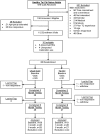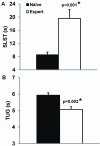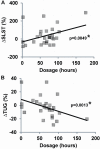Complexity-Based Measures Inform Effects of Tai Chi Training on Standing Postural Control: Cross-Sectional and Randomized Trial Studies
- PMID: 25494333
- PMCID: PMC4262457
- DOI: 10.1371/journal.pone.0114731
Complexity-Based Measures Inform Effects of Tai Chi Training on Standing Postural Control: Cross-Sectional and Randomized Trial Studies
Abstract
Background: Diminished control of standing balance, traditionally indicated by greater postural sway magnitude and speed, is associated with falls in older adults. Tai Chi (TC) is a multisystem intervention that reduces fall risk, yet its impact on sway measures vary considerably. We hypothesized that TC improves the integrated function of multiple control systems influencing balance, quantifiable by the multi-scale "complexity" of postural sway fluctuations.
Objectives: To evaluate both traditional and complexity-based measures of sway to characterize the short- and potential long-term effects of TC training on postural control and the relationships between sway measures and physical function in healthy older adults.
Methods: A cross-sectional comparison of standing postural sway in healthy TC-naïve and TC-expert (24.5±12 yrs experience) adults. TC-naïve participants then completed a 6-month, two-arm, wait-list randomized clinical trial of TC training. Postural sway was assessed before and after the training during standing on a force-plate with eyes-open (EO) and eyes-closed (EC). Anterior-posterior (AP) and medio-lateral (ML) sway speed, magnitude, and complexity (quantified by multiscale entropy) were calculated. Single-legged standing time and Timed-Up-and-Go tests characterized physical function.
Results: At baseline, compared to TC-naïve adults (n = 60, age 64.5±7.5 yrs), TC-experts (n = 27, age 62.8±7.5 yrs) exhibited greater complexity of sway in the AP EC (P = 0.023), ML EO (P<0.001), and ML EC (P<0.001) conditions. Traditional measures of sway speed and magnitude were not significantly lower among TC-experts. Intention-to-treat analyses indicated no significant effects of short-term TC training; however, increases in AP EC and ML EC complexity amongst those randomized to TC were positively correlated with practice hours (P = 0.044, P = 0.018). Long- and short-term TC training were positively associated with physical function.
Conclusion: Multiscale entropy offers a complementary approach to traditional COP measures for characterizing sway during quiet standing, and may be more sensitive to the effects of TC in healthy adults.
Trial registration: ClinicalTrials.gov NCT01340365.
Conflict of interest statement
Figures






References
-
- Shumway-Cook A, Woollacott M (2006) Motor Control: Translating Research into Clinical Practice: Philadelphia, Lippincott Williams and Wilkins. 576 p.
-
- Collins JJ, De Luca CJ (1993) Open-loop and closed-loop control of posture: a random-walk analysis of center-of-pressure trajectories. Exp Brain Res 95:308–318. - PubMed
-
- Duarte M, Sternad D (2008) Complexity of human postural control in young and older adults during prolonged standing. Exp Brain Res 191:265–276. - PubMed
-
- Cavanaugh JT, Guskiewicz KM, Stergiou N (2005) A nonlinear dynamic approach for evaluating postural control: new directions for the management of sport-related cerebral concussion. Sports Med 35:935–950. - PubMed
Publication types
MeSH terms
Associated data
Grants and funding
LinkOut - more resources
Full Text Sources
Other Literature Sources
Medical

